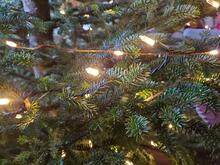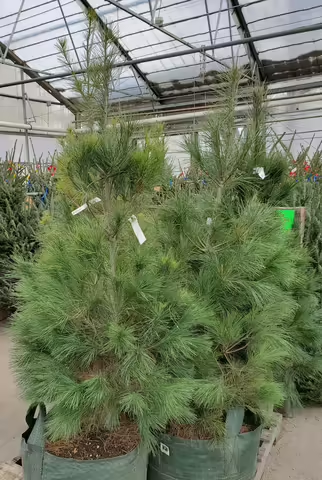Each year, millions of fresh cut Christmas trees are sold across the country adding to the hustle and bustle of the holiday season. Have you ever considered the sustainability of a fresh cut tree versus an artificial tree? Fake trees can last for many years, but what is the impact of their production? A cut tree likely takes less to produce, but is it a bad thing to cut a tree down?
I receive similar questions from potential tree buyers each year. For me, it is debatable either way and really depends on a variety of factors. Since this is such a tricky research question to address, there isn’t much scientific literature available, leaving it to the individual consumer to unpack.
Is an artificial tree right for you?
When you consider the production of artificial trees, the associated carbon footprint can look pretty bad. They are typically produced oversees and use a variety of plastics, metals and chemicals to create that life-like replica for lights and ornaments. Add in the shipping from distances afar and the carbon footprint really starts to accumulate. However, artificial trees can be used for many years, with each year of use spreading out the carbon footprint associated with the tree’s initial production.
How about real trees?
There is also a carbon cost associated with live tree production. Typically, pesticides and fertilizers may be used in Christmas tree production, along with the burning of fossil fuels to mow and maintain farm areas, as well as hauling trees from the field to the point of sale. If you purchase your fresh cut tree at larger retail stores, it’s a good bet it came from another state, further adding to the impact of shipping.
On the positive side, live trees sequester carbon while they grow, and research has shown that younger trees are able to sequester larger amounts of carbon due to their rapid growth. Since most Christmas trees are harvested at a young age, a tree production area consists of younger, more productive plants.
Furthermore, tree growth has less demand for nutrients than crop production, making marginal ag lands excellent tree farms and creating an economic opportunity for farmers willing to diversify production. Live trees are certainly recyclable, with many municipalities offering easy options to recycle these plants.
As another alternative, consider using a live plant as your holiday tree. Many garden centers offer live conifers that can be planted outdoors after their use for the holidays. Houseplants, such as Norfolk island pines (Araucaria heterophylla), are also great live specimens which make wonderful houseplants year round. Check out this past blog on The Norfolk Island Pine for more information.
Planting a live tree
Planting your live Christmas tree after holiday use is great for extending their ability to sequester carbon in the future. However, using a live tree does require special consideration, such as limiting its time spent indoors, planning when to dig the planting hole and getting it in the ground as soon as practical.
In addition, be sure that the species you purchase is well-adapted to our climate. Colorado blue spruce (Picea pungens) is common sold both as "live" Christmas trees and as a landscape plant, but there is no way i would recommend planting this non-native plant since it is poorly adapted to our climate. For more on the blue spruce issue, see this past blog - Two Trees You Should Never Plant in Illinois.
Research on sustainability
In 2018, one researcher at The Ohio State University assessed the environmental impact of real vs artificial trees by making some calculations for both options. Dr. Elizabeth M. Toman determined that the environmental impact of an artificial tree used for just four years equals the impact of buying fresh-cut trees for that same amount of time.
One of the biggest factors in Dr. Toman’s calculations was the distance traveled to buy a fresh-cut tree. She concluded that a 25 mile or longer trip to get your fresh-cut tree might equal the overall carbon footprint of the typical artificial tree, from production to arrival in your living room.
Another interesting aspect of the Christmas tree carbon footprint that Toman assessed was the type of lights we use to beauty our arboreal specimens. LED lights are by far more efficient than incandescent bulbs, but I was surprised to read that, by Toman’s calculations, just one year of holiday light from incandescent bulbs uses enough energy to exceed the amount required for manufacture, transport and disposal of any Christmas tree, real or artificial.
My tips on sustainable Christmas tree solutions
So, what does all this mean for the Christmas tree buyer interested in the most sustainable option? My recommendation is to go with the option that suites your family best and make decisions about the way you use your tree or acquire your tree to maximize its sustainability.
If you purchase an artificial tree, plan to use it for as many years as you can before it winds up in a landfill. For both live and fake trees, use led lights to lower energy use.
With a live tree, always plan to recycle it responsibly. There are typically easy options for recycling in your community, but I have also observed some interesting ways to recycle them your own garden. From bird feeders, to using small limbs as insulating mulch for overwinter plants, get innovative and recycle your tree in your own yard.
Get your live tree from a local farm. There are number of Christmas tree farms in our area and you may be much less than 25 miles from their location. Additionally, you are purchasing a local tree from a local business, building economic sustainability for small businesses in our area that can distribute a locally-grown product as opposed to larger retail outlets that may ship trees from states away. It's also just a wonderful experience to visit a tree farm and see how live trees are grown, but I may be a little biased toward trees.
In my opinion, buying a tree grown locally and using led lights for decoration may be the best option for reducing your tree’s carbon footprint.

